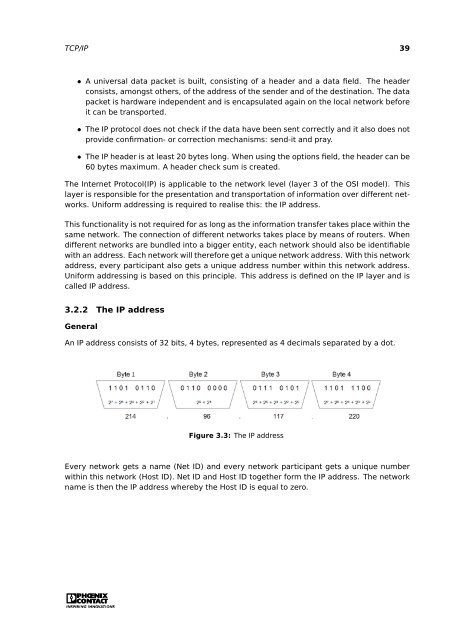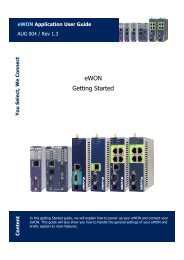Click to download Ethernet Basics manual - Grant Industrial Controls
Click to download Ethernet Basics manual - Grant Industrial Controls
Click to download Ethernet Basics manual - Grant Industrial Controls
Create successful ePaper yourself
Turn your PDF publications into a flip-book with our unique Google optimized e-Paper software.
TCP/IP 39<br />
• A universal data packet is built, consisting of a header and a data field. The header<br />
consists, amongst others, of the address of the sender and of the destination. The data<br />
packet is hardware independent and is encapsulated again on the local network before<br />
it can be transported.<br />
• The IP pro<strong>to</strong>col does not check if the data have been sent correctly and it also does not<br />
provide confirmation- or correction mechanisms: send-it and pray.<br />
• The IP header is at least 20 bytes long. When using the options field, the header can be<br />
60 bytes maximum. A header check sum is created.<br />
The Internet Pro<strong>to</strong>col(IP) is applicable <strong>to</strong> the network level (layer 3 of the OSI model). This<br />
layer is responsible for the presentation and transportation of information over different networks.<br />
Uniform addressing is required <strong>to</strong> realise this: the IP address.<br />
This functionality is not required for as long as the information transfer takes place within the<br />
same network. The connection of different networks takes place by means of routers. When<br />
different networks are bundled in<strong>to</strong> a bigger entity, each network should also be identifiable<br />
with an address. Each network will therefore get a unique network address. With this network<br />
address, every participant also gets a unique address number within this network address.<br />
Uniform addressing is based on this principle. This address is defined on the IP layer and is<br />
called IP address.<br />
3.2.2 The IP address<br />
General<br />
An IP address consists of 32 bits, 4 bytes, represented as 4 decimals separated by a dot.<br />
Figure 3.3: The IP address<br />
Every network gets a name (Net ID) and every network participant gets a unique number<br />
within this network (Host ID). Net ID and Host ID <strong>to</strong>gether form the IP address. The network<br />
name is then the IP address whereby the Host ID is equal <strong>to</strong> zero.




